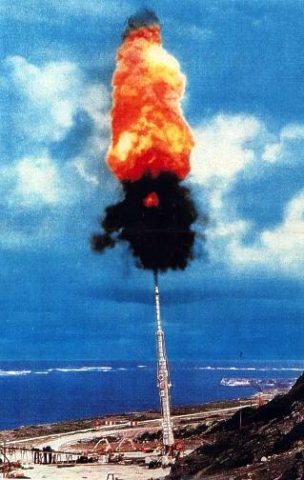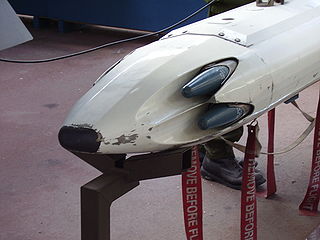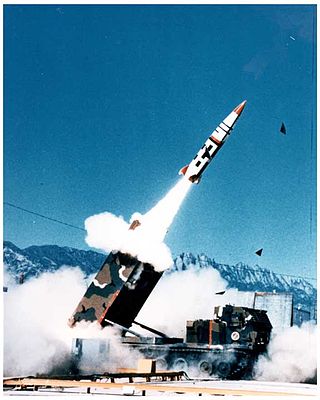
A solid-propellant rocket or solid rocket is a rocket with a rocket engine that uses solid propellants (fuel/oxidizer). The earliest rockets were solid-fuel rockets powered by gunpowder; they were used in warfare by the Chinese, Indians, Mongols and Persians as early as the 13th century.

Gerald Vincent Bull was a Canadian engineer who developed long-range artillery. He moved from project to project in his quest to economically launch a satellite using a huge artillery piece, to which end he designed the Project Babylon "supergun" for Saddam Hussein's government in Iraq.

Project HARP, short for High Altitude Research Project, was a joint venture of the United States Department of Defense and Canada's Department of National Defence created with the goal of studying ballistics of re-entry vehicles and collecting upper atmospheric data for research. Unlike conventional space launching methods that rely on rockets, HARP instead used very large guns to fire projectiles into the atmosphere at extremely high speeds.
The Velvet Glove was a short-range semi-active radar homing air-to-air missile designed by CARDE and produced by Canadair starting in 1953. 131 Velvet Gloves had been completed when the program was terminated in 1956, officially because of concerns about its ability to be launched at supersonic speeds from the Avro Arrow then under design, but also from the design being overtaken by developments in the United States.

The CRV7, short for "Canadian Rocket Vehicle 7", is a 2.75-inch (70 mm) folding-fin ground attack rocket produced by Bristol Aerospace in Winnipeg, Manitoba. It was introduced in the early 1970s as an upgraded version of the standard U.S. 2.75-inch air-to-ground rockets. It was the most powerful weapon of its class, the first with enough energy to penetrate standard Warsaw Pact aircraft hangars. The CRV7 remains one of the most powerful air-to-ground attack rockets to this day, and has slowly become the de facto standard for Western-aligned forces outside the United States. Beginning in 2021, 83,303 stored Canadian CRV7s are slated for disposal having been removed from service from 2005 to 2007.

Bristol Aerospace is a Canadian aerospace firm located in Winnipeg, Manitoba and is an operating division of Magellan Aerospace. Once part of the Bristol Aeroplane Company, today it is known as Magellan Aerospace, Winnipeg.

The MGR-1 Honest John rocket was the first nuclear-capable surface-to-surface rocket in the United States arsenal. Originally designated Artillery Rocket XM31, the first unit was tested on 29 June 1951, with the first production rounds delivered in January 1953. Its designation was changed to M31 in September 1953. The first Army units received their rockets by year's end and Honest John battalions were deployed in Europe in early 1954. Alternatively, the rocket was capable of carrying an ordinary high-explosive warhead weighing 1,500 pounds (680 kg).
Defence Research and Development Canada is the science and technology organization of the Department of National Defence (DND), whose purpose is to provide the Canadian Armed Forces (CAF), other government departments, and public safety and national security communities with knowledge and technology.
Trishul is a low-level quick-reaction short range surface-to-air missile developed in India by Defence Research and Development Organisation (DRDO) as part of the Integrated Guided Missile Development Programme (IGMDP). It can also be used as an anti-sea skimmer from naval ship against low flying missile, attack helicopter and aircraft.

Canadian Forces Base Suffield is a Canadian Forces base, host to the largest army training area in Canada. It is located in southeastern Alberta, 3 nautical miles north-northwest of Suffield, 50 km (31 mi) northwest of the city of Medicine Hat and 250 km (160 mi) southeast of Calgary. It is accessible via Highway 884, a public road that bisects the main hub section of the base.

A tactical ballistic missile (TBM), or battlefield range ballistic missile (BRBM), is a ballistic missile designed for short-range battlefield use. Typically, range is less than 300 kilometres (190 mi). Tactical ballistic missiles are usually mobile to ensure survivability and quick deployment, as well as carrying a variety of warheads to target enemy facilities, assembly areas, artillery, and other targets behind the front lines. Warheads can include conventional high explosive, chemical, biological, or nuclear warheads. Typically tactical nuclear weapons are limited in their total yield compared to strategic nuclear weapons.
Expenditures by federal and provincial organizations on scientific research and development accounted for about 10% of all such spending in Canada in 2006. These organizations are active in natural and social science research, engineering research, industrial research and medical research.
This article outlines the history of Canadian technological invention. Technologies chosen for treatment here include, in rough order, transportation, communication, energy, materials, industry, public works, public services, domestic/consumer and defence technologies.
The Defence Research Establishment Suffield was the name of the military research facility located 5 km (3.1 mi) north of Suffield, Alberta, from 1967 to its renaming to DRDC Suffield in 2000.
DRDC Suffield is a major Canadian military research facility located 5 km (3.1 mi) north of Suffield, Alberta, and is one of eight centres making up Defence Research and Development Canada (DRDC).

The Creative Research On Weapons or Crow program was an experimental missile project developed by the United States Navy's Naval Air Missile Test Center during the late 1950s. Intended to evaluate the solid-fueled integral rocket/ramjet (SFIRR) method of propulsion as well as solid-fueled ramjet engines, flight tests were conducted during the early 1960s with mixed success.
India has studied, produced and used various strategic and tactical missile systems since its independence. Decades long projects have realised development of all types of missile systems including ballistic, cruise, anti-ship, air-defence, air-to-air and anti-missile systems. India is one of seven countries in the world with intercontinental ballistic missiles (ICBMs) and one of four countries with anti-ballistic missile systems. Since 2016, India has been a member of Missile Technology Control Regime (MTCR).
The Biological and Chemical Defence Review Committee, or BCDRC is a civilian body having oversight of the Canadian military's activities in the area of defence against biological and chemical warfare.

Pralay is a canisterised Tactical, surface-to-surface, short-range ballistic missile (SRBM) for Battlefield use Developed by the Defence Research and Development Organisation (DRDO) of India. The Missile is an Amalgamation of Technologies Developed for exoatmospheric interceptor Missile Prithvi Defence Vehicle (PDV) from Indian Ballistic Missile Defence Programme and Prahaar tactical Missile. The Project to Develop Pralay was Sannctioned in March 2015 with a budget of ₹332.88 crore.

Solid Fuel Ducted Ramjet (SFDR) is a missile propulsion system currently being developed by the Defence Research and Development Organisation of India. The project aims to develop critical technologies required in the propulsion systems of future Indian long range air-to-air missiles.










